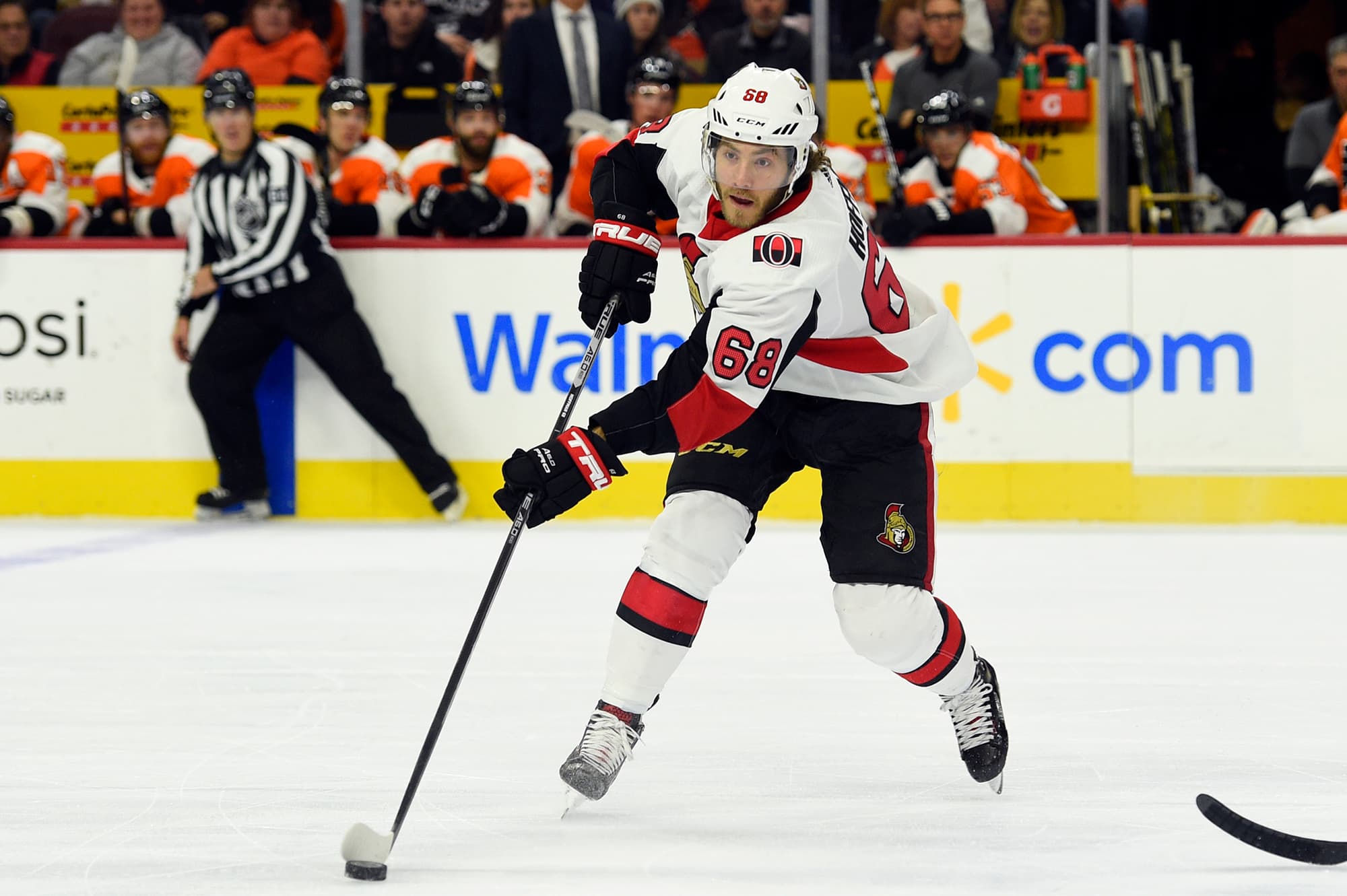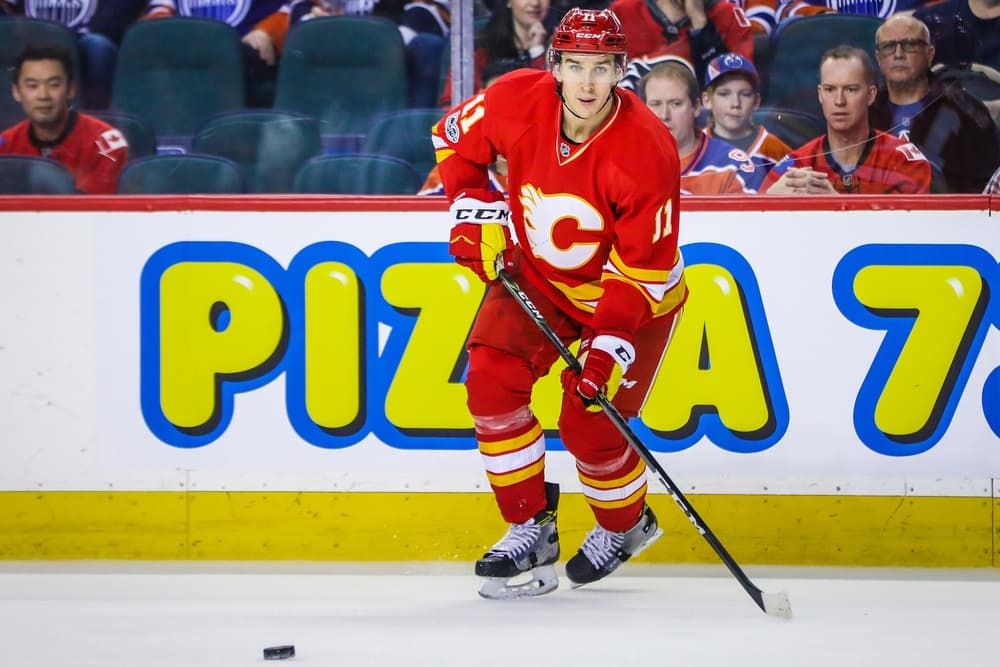Mark Jankowski and the tale of late bloomers

The feeling of animosity surrounding his name is not an unknown feeling for Calgary Flames centreman Mark Jankowski. After being selected in the first round, 21st overall, in the 2012 NHL Draft then-general manager Jay Feaster claimed that in 10 years the Stanstead College standout would “be viewed as the best player in the 2012 Draft.”
Seven years later, Jankowski has scored 31 goals and 58 points in 186 NHL games (0.31 PPG) with just 1 secondary assist in 34 games this season. With trade rumours howling his name in the wind, we may be seeing the last few games out of the Hamilton, Ontario native. With that, let’s visit other late bloomers who were in a similar position in prior years.
Mike Hoffman
While off-ice antics have smeared the Hoffman name somewhat, the sniper remains to be one of the most offensive dangers in the NHL despite a long and turbulent path to being a staple in the top six of an NHL lineup. The Kitchener, Ontario product was drafted in his Draft Plus 1 year, spent his Draft Plus 2 year in the QMJHL, and toiled in the minors for another four years (including a brief stint in the ECHL) before breaking into the NHL full time at the age of 25. Unlike the majority of superstars in the NHL, Mike Hoffman has faced a long path filled with uncertainty on way his way to the big leagues.
He is a classic reminder of the fact that regardless of how talented a player may be everyone develops at a different pace, as back in 2013 Hoffman was even put on waivers by the Ottawa Senators, which he cleared. While it’s certainly not expected for Jankowski to experience the offensive success that Hoffman has had, it is important to understand the similarities between the two players and realize that the former has already amassed nearly 200 NHL games at 25 years old, an age at which the latter just broke into the top league.

Despite being younger than Hoffman (and the other players he’s being compared with here), Jankowski’s underlying numbers and deployments stack up well. (All stats presented here are as of the 2019 holiday break.)
| Player | CF% (2017-2020) | Fenwick % (2017-2020) | Offensive Zone Start % | CF% Rel | AHL PPG |
| Mark Jankowski | 51.66% | 51.76% | 39.9% | -2.8 | 0.90 |
| Mike Hoffman | 48.81% | 48.78% | 58.6% | 2.8 | 0.70 |
Blake Wheeler
Winnipeg Jets sensation Blake Wheeler was labeled a project pick as soon as he was drafted, quite typical for a player drafted straight out of high school. The similarities between Jankowski and Wheeler from ages 17 to 22 are eerily similar; with both players being drafted out of high school and then playing NCAA hockey prior to starting their pro careers. The latter, unwilling to sign an entry-level deal with the Arizona Coyotes due to a contractual dispute, signed with the Boston Bruins as a free agent.
After playing for the Bruins for two and a half seasons, Wheeler was deemed expendable by Bruins brass and was sent to the Atlanta Thrashers along with Mark Stuart in exchange for Rich Peverley and Boris Valabik. The critique of Wheeler at the time was that he was unable to take advantage of his size and speed, a trait that Jankowski is often criticized for as well. Years later, with proper usage and development, Wheeler has been able to maximize the utility of all of his tools and is one of the best power forwards in hockey. It remains to be seen if Jankowski can do the same.

| Player | CF% (2017-2020) | Fenwick % (2017-2020) | Offensive Zone Start % | CF% Rel | AHL PPG |
| Mark Jankowski | 51.66% | 51.76% | 39.9% | -2.8 | 0.90 |
| Blake Wheeler | 49.41% | 49.80% | 54.6% | 1.9 | – |
Mikael Backlund
While the Calgary Flames are blessed to have such a talented centreman in Mikael Backlund, the Swede’s uneven path to the NHL has been well documented. In his rookie season with the Abbotsford Heat, then-Heat coach Jim Playfair ripped into Backlund calling him “spoiled” and claiming that he will “never make it to the NHL.” This was a result of Backlund’s lackluster effort during games and the centremen failing to be under the annual weigh-in. Years later when Backlund was asked to comment about this particular situation with Jim Playfair, he commented that he was “very close to quitting altogether.”
Both Jankowski and Backlund have put up eerily similar numbers during the first couple hundred games of their NHL careers, advanced stats included, and also both play in a two-way role for the team. Trade rumors have swirled around both centers quite early in their careers as well, making it all the harder for Calgary Flames brass to ship out Jankowski after overseeing the incredible development of Backlund.

| Player | CF% (2017-2020) | Fenwick % (2017-2020) | Offensive Zone Start % | CF% Rel | AHL PPG |
| Mark Jankowski | 51.66% | 51.76% | 39.9% | -2.8 | 0.90 |
| Mikael Backlund | 54.59% | 53.71% | 46.2% | 4.1 | 0.58 |
It’s worth noting that Jankowski is often buried in the defensive zone, with defensive specialist Backlund even getting more offensive-zone time than him. His low PDO of 0.974 even suggests that the centreman is better than his play would indicate and that he could be due for an offensive rebound.
One stat that drastically showcases a wart when differentiating between Jankowski and the players listed above is his Relative Corsi. Jankowski’s negative number indicates that Calgary Flames are better off with him on the bench, likely due to the team being outscored when his line is on the ice. While his Relative Corsi has been improving season by season, this is still a fairly troubling statistic; especially since all of the listed comparables boast positive values.
Jankowski’s future with the Calgary Flames and as a player in the NHL is filled with uncertainty. However, the abundance of successful comparable players certainly make it an interesting ordeal – and a situation that could pay off if the Flames continue to show patience with his development.
Recent articles from Prajeya Parmar





